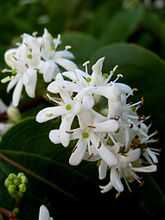Heptacodium miconioides
| Heptacodium miconioides | |
|---|---|
| | |
| H. miconioides, Mt Auburn Cemetery, Cambridge, Massachusetts, USA | |
| Conservation status | |
| Scientific classification | |
| Kingdom: | Plantae |
| (unranked): | Angiosperms |
| (unranked): | Eudicots |
| (unranked): | Asterids |
| Order: | Dipsacales |
| Family: | Caprifoliaceae |
| Genus: | Heptacodium |
| Species: | H. miconioides |
| Binomial name | |
| Heptacodium miconioides Rehder | |
| Synonyms | |
| |
Heptacodium miconioides, commonly known as the Seven Sons plant, is a member of the Caprifoliaceae family, a cousin of the Honeysuckle, and sole member of the genus Heptacodium. Endemic to China, this species was discovered in 1907 in Hubei province in central China by Wilson whilst collecting on behalf of the Arnold Arboretum. Considered rare at that time, the species is today threatened by habitat loss, and only nine populations are known to remain in the wild, all of them in Anhui and Zhejiang provinces.[2] The species is under second-class national protection in China.[3] However, the plant is now also widely grown as an ornamental around the world.
Description
H. miconioides is a deciduous large shrub or small tree, typically growing to a height of between 4 and 8 m. The bark of the trunk is papery and thin, light tan in colour, and exfoliates in strips or sheets. The upright, spreading, quadrangular branches give the plant a rounded, often irregular shape. The dark - green cordate leaves are opposite, 8–10 cm long by 5–6 cm wide, with entire margins and deeply impressed venation running parallel to the margin.[4] In September, H. miconioides produces large shows of small fragrant white blooms attractive to butterflies, the flowers five-petalled, < 13 mm across.[5] When the white corollas have fallen, the calyces develop into deep red expanded lobes which persist into November.
-

Heptacodium leaf.
-

Heptacodium flowers, close up.
Cultivation
The Sino-American Botanical Expedition of 1980 collected viable seeds which were sent to the Arnold Arboretum, where it was found to be easily cultivated. Readily propagated from either seed or by softwood cuttings, the species has since become widely available in North America and Europe, and was stocked by 26 nurseries in the UK alone in 2011.
H. miconioides is extremely hardy, and tolerant of temperatures as low as −35 °C (−31 °F). It is also fast-growing, and can reach a height of 3 m in just five years; it is also very shade tolerant.[4]
Notable trees
A specimen 8 m high planted in 1981 grows in the Flagpole Bed alongside Jermyn House at the Sir Harold Hillier Gardens, Ampfield, near Romsey, in England.
Etymology
The generic name of Heptacodium means 'seven flowers' (hence 'Seven Sons'), seven being the average number of flowers on a head. The specific epithet miconioides alludes to the similarities of the plant to the unrelated Meadow Beauty genus, Miconia.
References
- ↑ World Conservation Monitoring Centre (1998). "Heptacodium miconioides". IUCN Red List of Threatened Species. Version 2011.2. International Union for Conservation of Nature. Retrieved 13 April 2012.
- ↑ Lu, H. P.; Cai, Y. W.; Chen, X. Y.; Zhang, X.; Gu, Y. J.; Zhang, G. F. (2006). "High RAPD but no cpDNA sequence variation in the endemic and endangered plant, Heptacodium miconioides Rehd. (Caprifoliaceae)". Genetica 128 (1–3): 409–417. doi:10.1007/s10709-006-7542-x. PMID 17028968.
- ↑ "National key protected wild plants (first batch)". Nature Reserve of China. 2004-07-10. Retrieved 13 April 2012.
- ↑ 4.0 4.1 Koller, G. L. Seven-Son flower from Zhejiang: Introducing the versatile ornamental shrub Heptacodium jasminoides Airy Shaw. Arnoldia.
- ↑ Stebbings, G. (2011). Autumn Glory - Late Developers. Garden Answers, p. 48, September 2011. Bauer Media, London.
- Airy Shaw, H. K. (1952). A second species of the genus Heptacodium Rehd.(Caprifoliaceae). Kew Bulletin 1952, Number 2, pages 245-246.
| Wikimedia Commons has media related to Heptacodium miconioides. |
